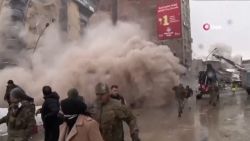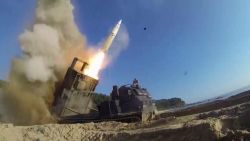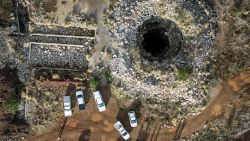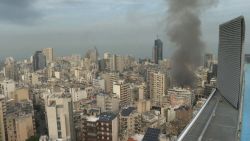The earthquake in Turkey is one of the deadliest this century. Here’s why | CNN (original) (raw)

Here's why the earthquake in Turkey and Syria was so deadly
02:34 - Source:CNN
World News 19 videos

Here's why the earthquake in Turkey and Syria was so deadly
02:34
Now playing
- Source:CNN

Masked burglars wanted for breaking into Windsor Castle estate
01:35
Now playing
- Source:CNN

How Russia is reacting to US authorizing Ukraine to use their long-range missiles
01:26
Now playing
- Source:CNN

See dramatic effects of climate change as sand dunes appear in Amazon rainforest
02:32
Now playing
- Source:CNN

Retired US colonel: Biden is sending a message to North Korea and China about supporting Russia
00:48
Now playing
- Source:CNN

National security expert decodes Zelensky's message to Trump
01:27
Now playing
- Source:CNN

Georgia election chief doused in paint after divisive parliamentary vote
00:51
Now playing
- Source:CNN

Video shows mine shaft where hundreds have been trapped for months without food or water
02:28
Now playing
- Source:CNN

UN report: Israel is intentionally causing death, starvation in Gaza
02:43
Now playing
- Source:CNN

Protesters storm parliament in disputed territory
00:53
Now playing
- Source:CNN

Russian state television reacts to Trump picking Gabbard and Gaetz
02:19
Now playing
- Source:CNN

New Zealand MPs perform haka during hearing in protest of proposed bill
01:39
Now playing
- Source:CNN

Scuffle breaks out during tense Israel-France football match
00:23
Now playing
- Source:CNN

'Get out or die': Civilians in Gaza flee with the clothes on their backs
02:59
Now playing
- Source:CNN

What we know about hundreds trapped in abandoned South African gold mines
02:42
Now playing
- Source:CNN

China shows off military as Putin touts a 'new world order'
02:54
Now playing
- Source:CNN

Retired colonel on potential fate of Ukraine following Trump win
02:25
Now playing
- Source:CNN

See inside the Trevi Fountain's renovation process
02:12
Now playing
- Source:CNN

More than a dozen Israeli strikes hit Beirut suburbs
01:09
Now playing
- Source:CNN
CNN —
Thousands of people have died and tens of thousands of others were injured by the devastating earthquakes that rocked Turkey and Syria on Monday.
Rescue teams are still desperately searching for signs of life beneath the rubble of collapsed buildings amid grim conditions, but days on from the massive tremblor, the chances of finding survivors lessen with every passing hour.
Here’s what we know about the quake and why it was so deadly.
One of the most powerful earthquakes to hit the region in a century rocked residents from their slumber in the early hours of Monday morning around 4 a.m. The 7.8 magnitude quake struck 23 kilometers (14.2 miles) east of Nurdagi, in Turkey’s Gaziantep province, at a depth of 24.1 kilometers (14.9 miles), the United States Geological Survey (USGS) said.
A series of aftershocks reverberated through the region in the immediate hours after the initial incident. A magnitude 6.7 aftershock followed 11 minutes after the first quake hit, but the largest temblor, which measured 7.5 in magnitude, struck about nine hours later. More than 125 aftershocks have been recorded so far.
Rescuers are now racing against time and the elements to pull survivors out from under debris on both sides of the border. More than 5,700 buildings in Turkey have collapsed, according to the country’s disaster agency.
Monday’s quake was also one of the strongest that Turkey has experienced in the last century – a 7.8 magnitude quake hit the east of the country in 1939, which resulted in more than 30,000 deaths, according to the USGS.
A number of factors have contributed to making this earthquake so lethal. One of them is the time of day it occurred. With the quake hitting early in the morning, many people were in their beds when it happened, and are now trapped under the rubble of their homes.
Additionally, with a cold and wet weather system moving through the region, poor conditions have made reaching affected areas trickier, and rescue and recovery efforts on both sides of the border significantly more challenging once teams have arrived.
Temperatures have been bitterly low, plummeting several degrees below zero on several occasions.
With scattered showers and snow in the region set to continue, the elements are putting the lives of those trapped underneath the rubble – who have already gone days without food and water – at risk of hypothermia. Meanwhile, officials have asked residents to leave buildings for their own safety amid concerns of more aftershocks.
More than 5,700 buildings in Turkey have collapsed, according to the country’s disaster agency, and questions have been asked about the integrity of structures in some areas of the affected regions.
“The thing that strikes mostly are the type of collapses – what we call the pancake collapse – which is the type of collapse that we engineers don’t like to see,” said Mustafa Erdik, a professor of earthquake engineering at Bogazici University in Istanbul. “In such collapses, it’s difficult – as you can see – and a very tragic to save lives. It makes the operation of the search and rescue teams very difficult.”
Erdik told CNN the images of widespread destruction and debris indicates “that there are highly variable qualities of designs and construction.” He says the type of structural failures following an earthquake are usually partial collapses. “Total collapses are something you always try to avoid both in codes and the actual design,” he added.
USGS structural engineer Kishor Jaiswal told CNN Tuesday that Turkey has experienced significant earthquakes in the past, including a quake in 1999 which hit southwest Turkey and killed more than 14,000 people. Because of this, he said, many parts of Turkey have regional building regulations to ensure construction projects can withstand these types of events.

Video shows trapped child comfort sibling under rubble
04:11 - Source:CNN
But not all buildings have been built according to the modern Turkish seismic standard, Jaiswal said. Deficiencies in the design and construction, especially in older buildings, mean that many buildings could not withstand the severity of the shocks.
“If you are not designing these structures for the seismic intensity that they may face in their design life, these structures may not perform well,” said Jaiswal.
Erdik also said he believed many of the buildings that have collapsed were likely “built pre-1999 or … with older codes.” He added there also would have been instances where some buildings didn’t conform to code.
“The codes are very modern in Turkey, very similar to US codes, but again, the codes conformity is an issue that we’ve tried to tackle with legal and administrative procedures.” he explained. “We have the permits from municipalities and controls for design, controls for construction. But then again, there are things that are lacking.”
Despite the mounting challenges, a structural engineer and humanitarian coordinator urged rescuers not to abandon hope as survivors could be found up to “weeks” after the massive earthquake hit the region. Kit Miyamoto, president of non-profit Miyamoto Global Disaster Relief, also praised the community in Turkey who came together and “did their part” after the quake struck.
“The community, the citizens, they’re the ones that are actually the first line of defense,” he told CNN Wednesday. “They dug up family, friends, neighbors.”
But other experts warn that the window for post-earthquake search-and-rescue is rapidly closing. Ilan Kelman, professor of disasters and health at University College London, said: “Typically, few survivors are pulled out after 72 hours – yet every life saved is essential and some people are extricated after many days.”
He added: “Time is always the enemy, as seen in Turkey and Syria. People die due to immediate medical needs such as bleeding to death or succumbing to crush injuries; due to aftershocks that collapse precarious structures with people underneath; and due to the weather which has dropped below freezing at night and which has been cold during the day, so people die through hypothermia. Many die from lacking food and water while awaiting rescue.”
Earthquakes occur on every continent in the world – from the highest peaks in the Himalayan Mountains to the lowest valleys, like the Dead Sea, to the bitterly cold regions of Antarctica. However, the distribution of these quakes is not random.
The USGS describes an earthquake as “the ground shaking caused by a sudden slip on a fault. Stresses in the earth’s outer layer push the sides of the fault together. Stress builds up and the rocks slip suddenly, releasing energy in waves that travel through the earth’s crust and cause the shaking that we feel during an earthquake.”
Earthquakes are measured using seismographs, which monitor the seismic waves that travel through the Earth after a quake.
Many may recognize the term “Richter Scale” which scientists previously used for many years, but these days they generally follow the Modified Mercalli Intensity Scale (MMI), which is a more accurate measure of a quake’s size, according to the USGS.
The power of an earthquake is known as magnitude. The intensity of the shaking can vary depending on the local geography and topography, and depth of the quake. On the magnitude scale, each increase of one whole number translates to 32 times more energy.
On this occasion, shaking from the 7.8 magnitude earthquake in southern Turkey could be felt as far as Israel and Lebanon, hundreds of kilometers away.
Turkey is no stranger to strong earthquakes, as it is situated along tectonic plate boundaries. Seven quakes with magnitude 7.0 or greater have struck the country in the past 25 years – but Monday’s was one of the most powerful.
It is also the strongest quake to hit anywhere in the world since an 8.1 magnitude quake struck a region near the South Sandwich Islands in the southern Atlantic Ocean in 2021, though the remote location of that incident resulted in little damage.
CNN’s meteorologist and severe weather expert Chad Myers said, “we always talk about the epicenter, but in this case we should talk about the epi-line.”
Two massive tectonic plates – the Arabian and the Eurasian – meet underneath Turkey’s southeastern provinces. Along this fault line, “about 100 miles from one side to the other, the earth slipped,” Myers continued.
Seismologists refer to this event as a “strike slip” – “where the plates are touching, and all of a sudden they slide sideways,” Myers said.
This is unlike the Ring of Fire, which runs along the west coast of the United States. In this zone, earthquakes and tsunamis are often caused by subduction – where one plate slides below another.
But in a “strike slip,” the plates move horizontally, rather than vertically. “Why that matters is because the buildings don’t want to go back and forth. And then the secondary waves begin to go back and forth as well,” Myers added.
Because of the nature of this seismic event, aftershocks could last “for weeks and months,” according to CNN meteorologist Karen Maginnis.
In comparison with other large earthquakes around the world, the 2011 Japan quake and tsunami – in which more than 22,000 people were killed or went missing – registered a magnitude of 9.1.
That incident left widespread destruction in its wake after walls of water engulfed entire towns, dragged houses onto highways and caused the country’s worst nuclear disaster on record.
A year before, in 2010, a magnitude 7.0 earthquake in Haiti is estimated to have killed between 220,000 to 300,000. A further 300,000 people were injured, and millions were displaced.
In 2004, an earthquake with an estimated magnitude of 9.1 struck the coast of Sumatra, Indonesia, causing a tsunami that left 227,898 people dead or listed as missing and presumed dead.
The strongest earthquake on record was a magnitude 9.5 in Chile in 1960, according to the USGS.